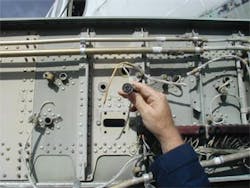SFAR 88, a mnemonic from the past (originally published in June of 2001)? Not really, based upon the last extension, the compliance deadline for SFAR 88 now modified by what is known as EAPAS/FTS, Enhanced Airworthiness Program for Airplane Systems, Fuel Tank Systems, is Dec. 16 of this year (2008). Moreover, the SFAR 88 reach has extended beyond fuel systems with the advancement EWIS (Electrical Wiring Interconnect Systems, more commonly referred to by technicians as “the wire bundles”). These regulations impact many aircraft, aircraft manufacturers, and operators. SFAR 88 (FTS) and EAPAS apply to airplanes that carry more than 30 passengers or that have more than 7,500 pounds maximum payload and operate under Part 121 or 129.
What are these regulations? Where did they come from?
In short, the new regulations require design approval holders (DAH, the TC, or STC holders frequently called OEMs) to inspect fuel system areas, wiring in their aircraft, and among other things, provide for corrective actions to prevent potential future problems. SFAR 88 or FTS section focuses on fuel systems and related wiring (ignition sources). EAPAS concerns all aspects of the continued airworthiness of EWIS — wiring throughout the airplane. While the new regulations may seem to create a lot of painstaking work, the benefits of preventive maintenance to the wiring will likely yield positive results and improved safety over the life of the aircraft.
There are various perspectives as to the impact of the regulations (the OEM standpoint, the aftermarket modification vendor standpoint, and the operator perspective). In this article, we’ll look at the opportunities that the fuel system-related EAPAS regulations bring to operators. We leave the rest of EAPAS to a future discussion.
Fuel system safety history
The aviation history that prompted the SFAR 88 effort is discussed in the preamble to the final rule found in the Federal Register at 66 FR 23086, May 7, 2001. The fuel system analysis rule was a direct result of TWA Flight 800 investigation, and has now been incorporated into the provisions of Part 25.
SFAR 88 requires manufacturers to perform an analytical assessment of the fuel tank system, including a consideration of lessons learned from the airplane service history. This assessment includes a review of the fuel tank components, the maintenance history of the aircraft, the maintenance history of the fleet of similar aircraft, and the service bulletins from the aircraft. Aftermarket modification manufacturers were to review their modifications related to the fuel system, including a listing of service bulletins for any components of the aircraft fuel system.
The main objective of the inspections is correction of deficiencies in design or maintenance that might give rise to an ignition source near the fuel system.
With a deadline of Dec. 16, 2008, there is not a lot of time to procrastinate. The industry cannot afford to revisit the groundings seen in the recent months. So what is the action? The deliverables upon completion of the safety assessment of the fleet fuel systems and related wiring are the ICA (Instructions for Continued Airworthiness), maintenance manual supplements, and maintenance training that incorporate the findings and remedies from the SFAR 88 Safety Assessment.
Again, the resulting effort is maintenance and inspection instructions to maintain the design features required to preclude the existence or development of an ignition source within the fuel tank system.
What to do with the info acquired?
The maintenance task descriptions and interval requirements produced by the OEM assessments may result in changes to maintenance and inspection instructions and to standard practices documents developed by design approval holders or OEMs. While an operator does not have to adopt the OEM’s ICA, maintenance, and inspection instructions, the operator will likely conform to the information provided because all new maintenance instructions, changes, or deviations to the EWIS or Fuel Tank System programs will require approval by the POI who will coordinate as necessary with the FAA Oversight Office.
The FAA has provided some minimum airworthiness limitation items (ALI) criteria for the maintenance instructions:
- The location of the fuel tank system components to be maintained or inspected and any access requirements
- Any unique procedures required, such as special detailed inspections or a dual sign-off maintenance record of requirements
- Specific task information, such as inspections defined by pictures or schematics
- Intervals for any repetitive task
- Methods, techniques and practices required to perform a task and the pass/fail criteria for any inspection
- Special equipment or testapparatus required
Inspections and corrective actions are not the end of SFAR 88/EAPAS-FTS. Training and maintenance techniques also play a part in compliance. Operators may prevent adverse effects associated with wiring changes by standardizing maintenance practices through training. Training may also prevent random wire routing and wire splicing and assist with explaining the important features of fuel tank system safety.
In addition to the design changes and inspections that have been noted by OEMs and STC holders, SFAR 88 with EAPAS-FTS creates the opportunity to enhance fuel system safety through regulatory driven improvements — in plain English: airworthiness directives, ADs. Operators should be noticing the fuel system related airworthiness directives that are being published as NPRMs and final rules. These ADs include operational aspects as well as wire protection. Compliance with some of these ADs may be achieved through AMOCs (alternative means of compliance) such as ground fault interrupters (GFIs), transient suppression devices (TSD), and other circuit protective devices. Companies are working on very economical and easy to implement AMOC solutions to the ADs.
This article is intended to be a reminder that the SFAR 88/EAPAS-FTS deadline will soon arrive. The more subtle suggestion is to incorporate the instructions earlier and obtain approvals of any necessary deviations.
Photos courtesy of Butler National Corp. Butler National Corp. is a supplier that not only provides solutions, but also helps the operators with advice and cost-effectively installing the products (TSDs and GFIs). Chris Reedy is an engineer, type-rated pilot, and published writer working for Butler National Corp., a company focused on manufacturing support systems for “Classic” commercial and military aircraft with products such as the Butler National TSD for the Boeing 737 and 747 “Classic” aircraft and the Butler National GFI for Classic and New Generation models. For more information visit www.butlernational.com.

